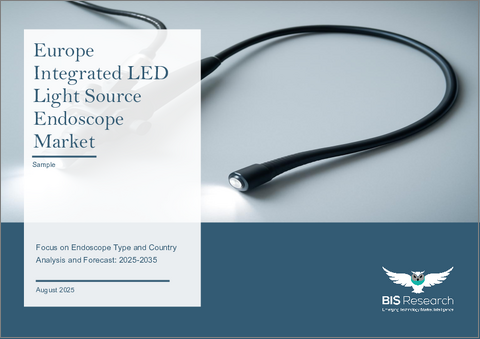|
|
市場調査レポート
商品コード
1794368
欧州の統合型LED光源内視鏡市場:内視鏡タイプと国別 - 分析と予測(2025年~2035年)Europe Integrated LED Light Source Endoscope Market: Focus on Endoscope Type and Country - Analysis and Forecast, 2025-2035 |
||||||
カスタマイズ可能
|
|||||||
| 欧州の統合型LED光源内視鏡市場:内視鏡タイプと国別 - 分析と予測(2025年~2035年) |
|
出版日: 2025年08月20日
発行: BIS Research
ページ情報: 英文 70 Pages
納期: 1~5営業日
|
全表示
- 概要
- 図表
- 目次
欧州の統合型LED光源内視鏡の市場規模は、2024年の2億4,160万米ドルから2035年には11億540万米ドルに達し、予測期間の2025年~2035年に14.02%のCAGRで拡大すると予測されています。
慢性疾患の罹患率の上昇、光源技術の継続的な進歩、地域の高齢化などが、欧州の統合型LED光源内視鏡市場の2桁近い目覚ましい成長に寄与しています。
| 主要市場統計 | |
|---|---|
| 予測期間 | 2025年~2035年 |
| 2025年の評価 | 2億9,760万米ドル |
| 2035年予測 | 11億540万米ドル |
| CAGR | 14.02% |
近年、最先端の内視鏡手術を行うヘルスケアプロバイダーが増えており、需要が高まっています。内視鏡システムの重要なコンポーネントである光源は、臓器内部の鮮明で高品質な可視化を提供することで、医師や外科医が低侵襲処置を行うことを可能にします。従来のキセノンやハロゲンに比べ、LEDベースの統合型光源は、高輝度、長寿命、低発熱、エネルギー効率の向上を実現しています。この動きは欧州で革命的なインパクトを与えました。
このような技術的進歩は、画質や診断精度を向上させるだけでなく、患者の安全性を高め、長期的な運用コストを削減し、手技効率を向上させる。このため、統合型LEDシステムの使用は欧州中の病院や手術センターの近代化をますます促進しており、照明技術の開発は市場の成長軌道に大きな影響を与えています。
市場イントロダクション
欧州の統合型LED光源内視鏡市場は、欧州大陸の高齢化、低侵襲手術への要望の高まり、技術進歩により急成長しています。最新の内視鏡システムには、内蔵型LED光源が必要です。LED光源は、医師が構造内部を正確に観察するのに役立つ、明るく信頼性の高い照明を提供するからです。従来のキセノンやハロゲンユニットに比べ、動作寿命が長く、エネルギー消費が少なく、発熱が少なく、画質が向上することは、すべてLEDベースのシステムの利点です。これらの利点は、手頃な価格で環境に優しいヘルスケア技術を求める欧州の動きと一致しています。
慢性肺疾患、泌尿器疾患、消化器疾患などの有病率の上昇は、日常的な内視鏡診断と治療を必要とし、成長をさらに後押ししています。重要なのは、EU医療機器規制(MDR2017/745)のような厳格な規制枠組みが欧州市場を独占していることです。こうした規制の結果、メーカーは現在、高品質で互換性のあるLEDベースのソリューションに投資しています。支払いの仕組みや適用範囲は地域によって異なるが、多くのEU諸国、特にドイツ、フランス、北欧諸国では、医学的に必要とされる内視鏡手術に対して、体系的な資金援助を行っています。これらの要素に加え、病院の近代化構想、感染管理規制、シングルユース機器への傾向の高まりが、統合型LED光源内視鏡の欧州市場を着実かつ力強く開拓しています。
市場セグメンテーション
セグメンテーション1:内視鏡タイプ別
- 単回使用内視鏡
- 再利用型内視鏡
セグメントテーション:地域別
- 欧州
- ドイツ
- フランス
- 英国
- イタリア
- スペイン
- デンマーク
- オランダ
- スイス
- その他
欧州の統合型LED光源内視鏡市場動向と促進要因・課題
市場動向
- 患者の回復時間の改善と入院の必要性の減少に支えられ、欧州全域で低侵襲処置の採用が拡大。
- キセノン光源に比べ、画像の鮮明さ、エネルギー効率、メンテナンスコストの低減を実現するLED技術を搭載した光源一体型内視鏡へのシフト。
- 診断精度と介入精度の向上を目的とした、内視鏡システムへのロボットとAIの統合の増加。
- 院内感染(HAI)リスク低減のための使い捨て内視鏡への嗜好の高まり。
- ビデオおよび可視化システムの技術的進歩による診断品質および採用率の向上。
主な成長要因
- 従来の光源に対するLEDの利点(長寿命、低発熱、安定した光出力)。
- より多くの診断および治療内視鏡手技を必要とする慢性疾患(消化器、肺、泌尿器)の有病率の増加。
- 内視鏡的介入を必要とする疾患に罹患しやすい欧州における高齢者人口の増加。
- HAIのリスクと意識が高く、無菌で効率的な統合システムへの需要が高まる。
- 先進的なLEDベースシステムの市場参入を支える規制認可とコンプライアンス。
- LED光源のメンテナンスと交換頻度の低減別長期的なコスト削減。
市場の課題
- 既存の再利用可能な内視鏡企業の優位性が、より新しい統合型LEDソリューションの採用を遅らせています。
- 高度な統合システムの初期資本投資が高く、小規模ヘルスケア施設での導入が制限されます。
- 高度な内視鏡機器を操作・保守する熟練専門家の不足。
- 欧州諸国における償還制限別購買決定への影響。
- 既存のキセノンベースまたはハロゲンシステムに多大な投資をしているヘルスケア施設の変化への抵抗。
製品/イノベーション戦略:欧州の統合型LED光源内視鏡市場は、製品、エンドユーザー、地域など様々なカテゴリーに基づいて広範囲にセグメント化されています。これにより、読者はどのセグメントが最大のシェアを占めているのか、またどのセグメントが今後数年間で成長するのに有利な位置にあるのかを明確に把握することができます。
競合戦略:欧州の統合型LED光源内視鏡市場には、製品ポートフォリオを持つ数多くの既存参入企業が存在します。本調査で分析・プロファイルした欧州LED光源一体型内視鏡市場の主要企業には、LED光源一体型内視鏡向け製品を提供する既存企業が含まれます。
主要市場参入企業と競合の要約
プロファイリングされた企業は、一次専門家から収集したインプットと、企業カバー率、製品ポートフォリオ、市場浸透度の分析に基づいて選定されています。
この市場で設立された著名な企業は以下の通りです。
- Ambu A/S
- Flexicare (Group) Limited
- KARL STORZ
- Richard Wolf GmbH
目次
エグゼクティブサマリー
第1章 市場:業界展望
- 市場概要とエコシステム
- 統合型LED光源内視鏡市場概要
- 再利用型内視鏡におけるLEDの浸透:現状と将来のシナリオ
- 市場動向
- 低侵襲手術への移行
- 単回使用内視鏡機器の採用拡大
- 償還シナリオ
- 規制状況/コンプライアンス
- 欧州
- サプライチェーン分析
- 内視鏡の費用
- 特許分析
- 特許出願動向(国別、年別)
- 市場力学
- 市場の促進要因
- 市場の抑制要因
- 市場の機会
第2章 統合型LED光源内視鏡市場(地域別)、100万米ドル、2023年~2035年
- 欧州
- 地域概要
- 市場成長促進要因
- 市場成長抑制要因
- ドイツ
- フランス
- 英国
- イタリア
- スペイン
- オランダ
- デンマーク
- スイス
- その他
第3章 市場-競合ベンチマーキングと企業プロファイル
- 主要戦略と開発
- 企業プロファイル
- Ambu A/S
- Flexicare (Group) Limited
- KARL STORZ
- Richard Wolf GmbH
第4章 調査手法
List of Figures
- Figure 1: Europe Integrated LED Light Source Endoscope Market (by Scenario), $Million, 2025, 2029, and 2035
- Figure 2: Integrated LED Light Source Endoscope Market, $Million, 2024 and 2035
- Figure 3: LED Roadmap
- Figure 4: Overview of Regulatory Landscape in Europe
- Figure 5: NHS Classification
- Figure 6: Supply Chain and Risks within the Supply Chain
- Figure 7: Integrated LED Light Source Endoscope Market, Patent Analysis (by Country), January 2019-April 2025
- Figure 8: Integrated LED Light Source Endoscope Market, Patent Analysis (by Year), January 2019-May 2025
- Figure 9: Number of Chronic Respiratory Disease (by Region), in Million, 2018-2021
- Figure 10: Increasing Aging Population Globally, Million, 2020-2023
- Figure 11: Europe Integrated LED Light Source Endoscope Market, $Million, 2023-2035
- Figure 12: Incidence of Bladder Cancer in Germany, 2022-2050
- Figure 13: Germany Integrated LED Light Source Endoscope Market, $Million, 2023-2035
- Figure 14: Incidence of Bladder Cancer in France, 2022-2050
- Figure 15: France Integrated LED Light Source Endoscope Market, $Million, 2023-2035
- Figure 16: Incidence of Bladder Cancer in the U.K., 2022-2050
- Figure 17: U.K. Integrated LED Light Source Endoscope Market, $Million, 2023-2035
- Figure 18: Incidence of Bladder Cancer in Italy, 2022-2050
- Figure 19: Italy Integrated LED Light Source Endoscope Market, $Million, 2023-2035
- Figure 20: Incidence of Bladder Cancer in Spain, 2022-2050
- Figure 21: Spain Integrated LED Light Source Endoscope Market, $Million, 2023-2035
- Figure 22: Incidence of Bladder Cancer in the Netherlands, 2022-2050
- Figure 23: Netherlands Integrated LED Light Source Endoscope Market, $Million, 2023-2035
- Figure 24: Incidence of Bladder Cancer in Denmark, 2022-2050
- Figure 25: Denmark Integrated LED Light Source Endoscope Market, $Million, 2023-2035
- Figure 26: Incidence of Bladder Cancer in Switzerland, 2022-2050
- Figure 27: Switzerland Integrated LED Light Source Endoscope Market, $Million, 2023-2035
- Figure 28: Incidence of Bladder Cancer in Rest-of-Europe, 2022-2050
- Figure 29: Rest-of-Europe Integrated LED Light Source Endoscope Market, $Million, 2023-2035
- Figure 30: Strategic Initiatives, January 2022-June 2025
- Figure 31: Data Triangulation
- Figure 32: Top-Down and Bottom-Up Approach
- Figure 33: Assumptions and Limitations
List of Tables
- Table 1: Market Snapshot
- Table 2: Trends: Current and Future Impact Assessment
- Table 3: Reimbursement Authorities for LED Endoscopes (by Region)
- Table 4: Cost Comparison for Bronchoscopy (by Components)
- Table 5: Cost Comparison for Reusable Vs. Single-Use Endoscopy
- Table 6: Drivers, Opportunities, and Challenges: Current and Future Impact Assessment
- Table 7: Some of the Developments of Technological Advancement
- Table 8: Price Comparison for Integrated LED Vs. External LED Endoscopy
- Table 9: Integrated LED Light Source Endoscope Market (by Region), $Million, 2023-2035
- Table 10: Europe Integrated LED Light Source Endoscope Market (by Type), Units Sold, Units, 2023-2035
- Table 11: Europe Integrated LED Light Source Endoscope Market (by Type), $Million, 2023-2035
- Table 12: Key Strategies, January 2022-June 2025
This report can be delivered in 2 working days.
Introduction to Europe Integrated LED Light Source Endoscope Market
The Europe integrated LED light source endoscope market is projected to reach $1,105.4 million by 2035 from $241.6 million in 2024, growing at a CAGR of 14.02% during the forecast period 2025-2035. The growing incidence of chronic illnesses, ongoing advancements in light source technology, and the region's aging population have all contributed to the impressive, nearly double-digit growth of the European integrated LED light source endoscope market.
| KEY MARKET STATISTICS | |
|---|---|
| Forecast Period | 2025 - 2035 |
| 2025 Evaluation | $297.6 Million |
| 2035 Forecast | $1,105.4 Million |
| CAGR | 14.02% |
Demand has increased recently as more healthcare providers use cutting-edge endoscopic procedures. A vital component of endoscopic systems, light sources allow doctors and surgeons to perform minimally invasive procedures by providing clear, high-quality visualization of inside organs. Compared to conventional xenon or halogen choices, LED-based integrated light sources offer higher brightness, a longer operational lifespan, lower heat emission, and enhanced energy efficiency. This move has had a revolutionary impact in Europe.
These technological advancements not only improve image quality and diagnostic accuracy, but they also improve patient safety, lower operating costs over time, and increase procedural efficiency. Because of this, the use of integrated LED systems is increasingly driving modernization in hospitals and surgical centers throughout Europe, and developments in lighting technology are significantly influencing the market's growth trajectory.
Market Introduction
The market for integrated LED light source endoscopes in Europe is growing quickly due to the continent's aging population, growing desire for minimally invasive operations, and technical advancements. Modern endoscopic systems require integrated LED light sources because they provide brilliant, reliable illumination that helps doctors precisely view inside structures. Longer operating lifespans, lower energy consumption, less heat generation, and improved image quality are all advantages of LED-based systems over conventional xenon or halogen units. These advantages are in line with Europe's drive for affordable and environmentally friendly healthcare technology.
The growing prevalence of chronic pulmonary, urological, and gastrointestinal conditions-all of which necessitate routine endoscopic diagnosis and treatment-further supports growth. Crucially, stringent regulatory frameworks like the EU Medical Device Regulation (MDR 2017/745), which imposes stringent safety, performance, and post-market surveillance standards, govern the European market. Manufacturers are now investing in high-quality, compatible LED-based solutions as a result of these rules. Although payment mechanisms and coverage differ by area, many EU nations-especially Germany, France, and the Nordic states-offer structured funding for endoscopic operations that are medically required. These elements, together with hospital modernization initiatives, infection control regulations, and a growing trend toward single-use devices, are driving the European market for integrated LED light source endoscopes toward steady and strong development.
Market Segmentation:
Segmentation 1: by Endoscope Type
- Single-Use Endoscope
- Reusable Endoscope
Segmentation 2: by Region
- Europe
- Germany
- France
- U.K.
- Italy
- Spain
- Denmark
- Netherland
- Switzerland
- Rest-of-Europe
Europe Integrated LED Light Source Endoscope Market Trend, Drivers and Challenges-
Market Trends
- Growing adoption of minimally invasive procedures across Europe, supported by better patient recovery times and reduced hospitalization needs.
- Shift towards integrated light source endoscopes with LED technology for enhanced image clarity, energy efficiency, and lower maintenance costs compared to xenon light sources.
- Increasing integration of robotics and AI into endoscopic systems for improved diagnostic accuracy and precision in interventions.
- Rising preference for single-use/disposable endoscopes to reduce hospital-acquired infection (HAI) risks.
- Technological advances in video and visualization systems driving higher diagnostic quality and adoption rates.
Key Growth Drivers
- Advantages of LED over traditional light sources (longer lifespan, lower heat emission, consistent light output).
- Increasing prevalence of chronic diseases (gastrointestinal, pulmonary, urological) necessitating more diagnostic and therapeutic endoscopic procedures.
- Growing geriatric population in Europe, which is more prone to conditions requiring endoscopic intervention.
- High risk and awareness of HAIs, boosting demand for sterile and efficient integrated systems.
- Regulatory approvals and compliance supporting market entry of advanced LED-based systems.
- Cost savings over time due to lower maintenance and replacement frequency of LED light sources.
Market Challenges
- Dominance of existing reusable endoscope enterprises slowing adoption of newer integrated LED solutions.
- High initial capital investment for advanced integrated systems, limiting uptake among smaller healthcare facilities.
- Shortage of skilled professionals to operate and maintain advanced endoscopic equipment.
- Reimbursement limitations in certain European countries, affecting purchasing decisions.
- Resistance to change from healthcare facilities heavily invested in existing xenon-based or halogen systems.
How can this report add value to an organization?
Product/Innovation Strategy: The Europe integrated LED light source endoscope market has been extensively segmented based on various categories, such as product, end user, and region. This can help readers get a clear overview of which segments account for the largest share and which ones are well-positioned to grow in the coming years.
Growth/Marketing Strategy: Product approvals accounted for the maximum number of key developments.
Competitive Strategy: The Europe integrated LED light source endoscope market has numerous established players with product portfolios. Key players in the Europe integrated LED light source endoscope market analyzed and profiled in the study include established players offering products for the integrated LED light source endoscope.
Key Market Players and Competition Synopsis
The companies profiled have been selected based on inputs gathered from primary experts and an analysis of company coverage, product portfolio, and market penetration.
Some prominent names established in this market are:
- Ambu A/S
- Flexicare (Group) Limited
- KARL STORZ
- Richard Wolf GmbH
Table of Contents
Executive Summary
Scope and Definition
1 Market: Industry Outlook
- 1.1 Market Overview and Ecosystem
- 1.1.1 Integrated LED Light Source Endoscope Market Overview
- 1.1.2 LED Penetration in Reusable Endoscopes: Current vs. Future Scenario
- 1.2 Market Trends
- 1.2.1 Shifts toward Minimal Invasive Surgeries
- 1.2.2 Growing Adoption of Single-Use Endoscope Devices
- 1.3 Reimbursement Scenario
- 1.4 Regulatory Landscape/Compliance
- 1.4.1 Europe
- 1.4.1.1 U.K.
- 1.4.1 Europe
- 1.5 Supply Chain Analysis
- 1.6 Cost of the Endoscope
- 1.7 Patent Analysis
- 1.7.1 Patent Filing Trend (by Country, Year)
- 1.8 Market Dynamics
- 1.8.1 Market Drivers
- 1.8.1.1 Increasing Prevalence of Chronic Diseases Upsurge the Demand for Endoscopy Procedures
- 1.8.1.2 Rising Aging Population
- 1.8.1.3 Continuous Technological Advancements in Light Sources
- 1.8.2 Market Restraints
- 1.8.2.1 Efficient Light Coupling and Heat Dissipation in LED-Based Endoscopic Illumination
- 1.8.2.2 High Cost of LED Endoscope
- 1.8.3 Market Opportunities
- 1.8.3.1 Growing Healthcare Industry in Emerging Countries
- 1.8.1 Market Drivers
2 Integrated LED Light Source Endoscope Market (By Region), $Million, 2023-2035
- 2.1 Europe
- 2.1.1 Regional Overview
- 2.1.2 Driving Factors for Market Growth
- 2.1.3 Factors Challenging the Market
- 2.1.4 Germany
- 2.1.5 France
- 2.1.6 U.K.
- 2.1.7 Italy
- 2.1.8 Spain
- 2.1.9 Netherlands
- 2.1.10 Denmark
- 2.1.11 Switzerland
- 2.1.12 Rest-of-Europe
3 Markets - Competitive Benchmarking & Company Profiles
- 3.1 Key Strategies and Developments
- 3.2 Company Profiles
- 3.2.1 Ambu A/S
- 3.2.1.1 Overview
- 3.2.1.2 Top Products/Product Portfolio
- 3.2.1.3 Top Competitors
- 3.2.1.4 Target Customers
- 3.2.1.5 Key Personal
- 3.2.1.6 Analyst View
- 3.2.2 Flexicare (Group) Limited
- 3.2.2.1 Overview
- 3.2.2.2 Top Products/Product Portfolio
- 3.2.2.3 Top Competitors
- 3.2.2.4 Target Customers
- 3.2.2.5 Key Personal
- 3.2.2.6 Analyst View
- 3.2.3 KARL STORZ
- 3.2.3.1 Overview
- 3.2.3.2 Top Products/Product Portfolio
- 3.2.3.3 Top Competitors
- 3.2.3.4 Target Customers
- 3.2.3.5 Key Personal
- 3.2.3.6 Analyst View
- 3.2.4 Richard Wolf GmbH
- 3.2.4.1 Overview
- 3.2.4.2 Top Products/Product Portfolio
- 3.2.4.3 Top Competitors
- 3.2.4.4 Target Customers
- 3.2.4.5 Key Personal
- 3.2.4.6 Analyst View
- 3.2.1 Ambu A/S
4 Research Methodology
- 4.1 Data Sources
- 4.1.1 Primary Data Sources
- 4.1.2 Secondary Data Sources
- 4.1.3 Data Triangulation
- 4.2 Market Estimation and Forecast






